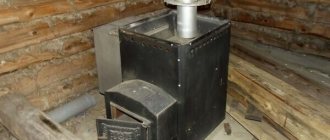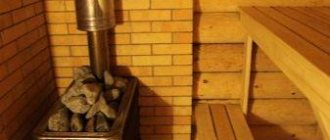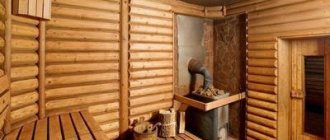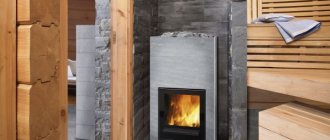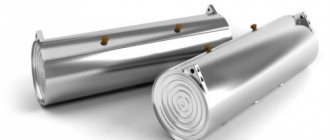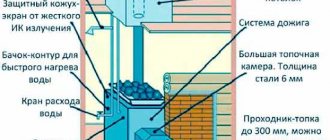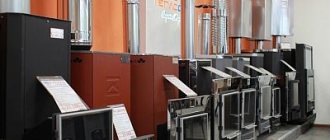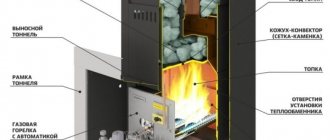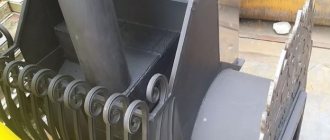Owners of private estates, cottages, and country houses sooner or later begin to build the walls of their own bathhouse. By the time design work begins, the question arises of choosing the basis of the entire building - the stove. “Varvara” is one of the most common brands of sauna stoves. They are found in buildings of different designs and sizes, located both in the central part and in the Russian outback. Each sample in this series has its own characteristics and is adapted for specific operating conditions. "Varvara" is produced in Tver. Demand for products has been stable for over ten years, which indicates the quality of the product.
- 2 Model Volzhanka
- 3 General characteristics
- 4 Furnace design
- 5 Main advantages
- 6 Disadvantages of Varvara stoves
- 7 “Varvara” with brickwork
- 8 Reviews of stoves of the “Varvara” series
Model Terma-Skazka
There are currently 8 models of sauna stoves available. The most popular medium-sized stove is the Terma-Skazka stove with a closed heater. A distinctive feature of this model is that the stove heater is lined with soapstone stone. This allows you to obtain soft steam by heating the stone to higher temperatures. Main characteristics:
- Height x Width x Length - 1120 x 500 x 800
- Weight - 245 kg
- Steam room volume - 12-24 cubic meters
- How many stones can you put - 60-70 kg
- Firebox length - 76cm
- What to heat with - wood
- Manufacturer's recommended price - 49,500 rubles
Chimney cleaning options
Most often, one of three methods is used to clean a brick oven from soot:
- Mechanical . A brush is used as a tool to clean the inner walls of soot. A prerequisite is access to the pipe, and this is not always feasible. Not everyone has the skill to climb on a roof (especially on steep structures). There is also an option for cleaning from below, which requires a flexible rod. During the procedure, the knocked down soot is poured down, after which it has to be collected and taken out. All this is accompanied by the formation of caustic dust and contamination of the surface of the stove or fireplace. It is best to place a large container under the crumbling dirt in advance.
- Chemical . Special powders and briquettes are available for sale for this purpose. As the fire proceeds, the powders must be poured into the fire, and the briquettes must be thrown into the flame. The active components included in their composition help soften the soot. As a result, it gradually evaporates outward (although it can fall down in a layer and create a plug). This method of how to clean a stove from soot is more preventive.
- People 's Since furnaces have been used for centuries, we had to deal with soot before. It is clear that non-chemical methods were used for this. In ancient cities there was even such a profession as a chimney sweep, for whose services you had to shell out a lot of money. The cleaning agents for stoves and chimneys were often salt or potato waste.
If there is no opportunity or desire to do this dirty work, you can contact the fire department and call specialists. Although they are not called chimney sweeps, they perform the same functions. These teams have the appropriate equipment and approval to work with explosive soot.
Model Volzhanka
Volzhanka is designed for large steam rooms. The water tank is made of stainless steel. Main characteristics:
- Height x Width x Length - 1000 x 510 x 820
- Weight - 150 kg
- Steam room volume - 24-35 cubic meters
- How many stones can you put - 60-80 kg
- Firebox length - 72cm
- What to heat with - wood
- Manufacturer's recommended price: 24,700 rubles
In addition to the described models, the company’s product line also includes the so-called Mini Panorama Ovens. They are very compact, come in various sizes, and have a panoramic door. There are models with an extended firebox or a hanging tank.
"Kamenka-Mini"
The stove, the body of which is made of high-strength steel 6 mm thick, is excellent for installation in miniature steam rooms. The firebox can fill the atmosphere of the bathhouse with the desired notes of primordiality. In addition, it will serve faithfully for many years, as it resists the destructive effects of negative environmental factors and has first-class technical characteristics. They are:
- dimensions – 66×47.5×71 cm;
- power – 12 kW;
- weight – 85 kg;
- fuel type - firewood;
- steam room volume – 16 m3;
- weight of stones – 100 kg;
- glass parameters – 23.5×25.5 cm.
The cost of the heating device is from 13,000 rubles.
General characteristics
There are currently 8 models of sauna stoves available.
A well-thought-out design allows us to limit ourselves to the production of a small number of models that can be configured to meet the specific requirements of the buyer:
- Standard oven without tank and heat exchanger.
- Modification of the same furnace with a water heating circuit .
- A stove with a water tank mounted on its side.
It’s just that a stove, which does not have a heated container included, is used in cases where it is only necessary to create the desired atmosphere in the room and steam room. The water heating functions are performed by other devices (gas water heater or electric boiler).
The built-in water heating circuit allows you to equip the stove with a capacity of up to 120 liters.
Most often, it is installed at the top, acting as a matching element, between the hot pipe and the ceiling. The user receives a double benefit - the pipe heats the liquid in the tank, which eliminates the need to use protective materials to isolate the pipe from the floor and ceiling materials. The number 120 cannot serve as the final characteristic of the model; when purchasing a stove complete with a tank, its size can be limited to 50 or 60 liters. This model allows the installation of a water tank in another location (outside the steam room).
The second feature of this model is the possibility of using the stove as a boiler as part of a water heating system using batteries (registers). The use of liquid heating or the presence of a tank with large dimensions is a consequence of the use of an external water supply for filling them.
Typically, the side tank has a capacity of up to 60 liters . This allows you to get the optimal amount of hot water and meet the specified time interval for heating it.
All of the listed stove options are designed for a steam room volume of up to 24 cubic meters. meters. There are smaller options - “Varvara-mini” , which, having its own weight of 82 kg, can heat a steam room up to 12 cubic meters. meters. These babies are designed for a spacious heater and are complemented by a side tank of 39 liters.
Brand series and their brief description
Stoves are presented on the market in several lines:
- "Fairy Tale" and "Thermal Fairy Tale" . They belong to the convection-storage type of ovens. A bathhouse with a volume of up to 24 m3 is heated to the maximum, maintaining heat for a long time. The body is made of soapstone. There is a reservoir for stones: the “Skazka” has an open heater, and the “Terma Skazka” has a closed stove with a lid. This group includes subspecies with the prefix “mini”. These models differ in that they heat rooms up to 12 m3.
- "Kamenka" and "Therma Kamenka" . The first line has a closed heater, suitable for heating rooms of 12 m3 or 24 m3, depending on the modification. The second is stoves with open heaters, with similar characteristics.
- “Mini” - “without contour”, “mounted”, “with contour”. They are small in size, but are equipped with a spacious water tank - 50 or 55 liters. Suitable for installation in small steam rooms with a volume of 18 m3.
Furnace design
The simplicity of the “Barbara” design is the basis of its attractiveness. Structurally, it is represented by a set of key elements:
- Stove firebox . This is where wood combustion takes place. The released energy is communicated to the main structure in the form of heat.
- Next to the firebox there is a chamber where the final decay of the resulting gases (smoke) occurs.
- The system of ash pan and cast iron grates allows you to regulate the fuel combustion process (its intensity), creating an air flow into the firebox. Another function of the unit is the collection of solid combustion products (ash and coals).
- Thoughtful design of chimneys .
- A casing that transfers its own heat to the surrounding air masses and heats the heater.
A significant difference between the furnaces is the use of a special opening on the back of the main body to clean the combustion zone from soot.
For models equipped with a heating circuit, a tank is used, for the manufacture of which a stainless alloy is used, the sheet thickness of which is at least 1.5 mm.
Distinctive features
He develops bath units and supplies them to Russian markets from Tver . The manufacturer has created a whole model range, which includes budget and high-performance models.
To better describe the product and identify its features, we should consider the simplest design.
The design of the stoves is quite typical and simple.
Consist of the following elements:
- combustion chamber for burning fuel;
- afterburning systems in which flue gases disintegrate;
- grate and ash scoop;
- chimney;
- a protective casing that ensures heat transfer from stones into the room.
The operating principle is as follows:
- Cold air enters the convection channels (they are located between the stove and the casing) and is heated under the influence of draft. Then it rises and enters the steam room through the holes.
- Hot air circulates in the internal convection channel. Due to this, rapid heating of the stones is observed.
- Additionally, the combustion intensity is adjusted. All a person needs to do is open or close the ash scoop.
IMPORTANT!
The self-cleaning system is an important component of this brand of ovens.
It is a hole with a plug on the back of the unit . It is easy to clean with a regular brush.
Main advantages
When choosing a stove from the “Varvara” series for their bathhouse, the average consumer pays attention to a number of its distinctive features, which favorably emphasize the correctness of the choice . These include:
- Simplicity and reliability of execution.
- Favorable location in the price space.
- Ease of installation.
- The weight of the complex allows the installation of a furnace without installing a reinforced foundation.
- Good case design.
- Overall dimensions that make it possible to successfully fit the design into any interior.
- The vapor removal pipe located on the tank makes the air in the steam room similar to the air in a good sauna with a brick oven.
Illustrative examples in the interior
Heating structures from the Varvara brand can be used in any stylistic image. Let's look at some variations that are most popular at the moment.
Classic style
The interior of a bathhouse in a classic style involves the use of natural wood. Regardless of the size of the room, the design is characterized by basic elements.
- Current accessories: handmade bast shoes on the walls, amulets, a wooden bucket with a ladle, runners on the benches. The effect of antiquity is created precisely due to such elements.
- Shelves, which are made from solid wood, can be of different designs.
- A heater stove is the main attribute of a Russian bath. It is mainly made of brick, and the cladding is made using natural stone. The best option is to buy a ready-made stove made of steel and have the lining made of stone.
- Lighting. To create a warm atmosphere in the room, it is better to use spotlights or sconces with lampshades.
- Furniture set. In this case, massive wooden tables with benches are used.
- Fragrances. A real Russian bathhouse is characterized not only by its wooden structure, but also by its specific smells. To relax and calm the body, use aromatic oils from lavender, eucalyptus, and the aroma of steamed birch broom will have a calming effect on a person.
Modern style
Modern baths have large room sizes. Additionally, there are relaxation rooms, a shower room, a swimming pool, and a veranda. The lounge room is equipped with additional furniture (plasma TV, armchairs, sofa, table). The outdated brick stove is being replaced with a portable metal structure.
The walls of the steam room are lined with wooden clapboards, which must be located in a vertical position. Thanks to this, there is less accumulation of condensation in the cracks. The floor in a modern bathhouse can be not only wooden, but also tiled. The modern look suggests installing lighting fixtures anywhere, even at the edges of shelves.
To learn why you need to choose a stove for a “Varvara” bathhouse, see the following video.
Disadvantages of Varvara stoves
The process of long-term use helped to identify certain shortcomings of such installations:
- The heating time of a large water tank is longer than in similar types of stoves from other manufacturers. As a justification, we should mention the existence of containers whose reduced dimensions reduce heating time. Another way to combat the problem is to install an additional heat exchange circuit on the pipe . The problem is solved, but there is a need to constantly monitor the temperature of the liquid, which can actually boil.
- The slow burning principle used and the presence of an additional chamber for the complete disintegration of all gases, together with improper installation of the pipe, leads to the accumulation and flow of condensing water drops along it . For the stove to function properly, the pipe must be long and protrude beyond the upper boundary of the tank.
Kinds
Currently, the company produces three types of heaters:
- a device with a tank on a pipe located at the top (volume 120 l);
- equipment without a water tank;
- a device with a water tank located on the side (volume 50 l).
The first type is perfect for baths that are connected to a central water supply. The second is good for saunas in which water is heated using an electric heater. And the third is great for steam rooms that are not connected to the central water supply.
"Varvara" with brickwork
The usual body of representatives of this series has a very attractive appearance, but for lovers of the Russian spirit of the bathhouse, it is proposed to use the method of creating an additional brick screen.
The advantages of this improved design will be:
- increased thermal capacity of the structure. The brick will accumulate the energy received and release it gradually as it cools;
- a special design that differs from analogues (especially if natural stone is used instead of brickwork);
- along with the appearance, another filling of the space with dry heat , characteristic only of the steam rooms of Russian baths.
The main disadvantage of this installation method is the large mass of bricks , which, when added to the weight of the stove, leads to the need to install a new stove foundation.
The second problem is finding a qualified stove master who will make high-quality masonry based on a composition suitable for high temperatures from a mixture of clay (preferably fireclay) and sand.
The reason for the wide popularity of the manufactured bath heating units was a detailed acquaintance with all the problems that arose during the operation of similar systems in the past. A detailed study of the demand for stoves and the possible market for their sales has led to a high level of use of their products by the population.
The resulting model range has many positive qualities that the consumer needs, and possible disadvantages are minimized.
Tips for installation and operation
The Varvara sauna stoves are lightweight, so their installation is simple. Before this process, it is recommended to heat the equipment outside so that the smell from the substances and oils used in production disappears.
After firing in the open air, the stove is installed in the steam room:
- One side of the foundation is placed under the wall so that only the stove screen extends into the recreation room. It is covered with waterproofing material, cutting the wall begins with 2 crowns. As a result, the foundation is as close as possible to the wall. The brick screen is combined with the other side of the stove in the steam room.
- The first row of bricks is laid on the mortar. The stove is installed on the 2nd row of brickwork.
- In areas near the combustion chamber, refractory bricks are used. In other areas it is allowed to use lining. His sinuses are filled with sand.
- The brick screen is made from a fire-resistant clay mass that can withstand temperatures up to +1500 degrees.
- A piece suitable for the screen is cut out of a metal sheet, which can later be used to cover the area of the heater.
- Two small doors are installed at the bottom of the masonry, while large doors are installed on opposite sides of the stove structure. This is necessary to create air flow. Between the doors it will be possible to switch the flow of air under the stove in different modes: from the rest room or from the washing room.
It is better to use dry firewood to fire Varvara. Burning with wood briquettes is also allowed. It is necessary to ignite the fuel with the chimney open and the ash pan open by 5 cm. The combustion chamber door is kept closed when igniting. When the firewood is fully heated, the ash compartment is completely closed and the firebox is slightly covered.
During operation, the water tank is cleaned every 1 - 2 months.
Expert opinion
Lovkachev Boris Petrovich
Bath master who knows everything about steaming
Attention! Do not use resinous wood to fire a sauna stove. In this case, there will be excessive soot deposits on the walls of the chimney and will require more frequent cleaning. Sometimes, if there is excessive deposits, it is impossible to clean the chimney ducts and the stove must be disassembled.
How to clean the inside?
Many people are interested in knowing how to clean a stove pipe when it is not possible to get to it on the roof. Suitable for cleaning the inside of a house or bathhouse. For this purpose, devices have been developed - brushes on flexible rods. You can also buy them in construction markets.
Experts sometimes use a vacuum cleaner to clean the stove. It is better not to try this on your own: standard home vacuum cleaners will not help here. They have little traction and, in addition, soot in them can cause an electrical appliance to catch fire.
Getting to the chimney to clean the fireplace portal without disassembling it is quite simple. When cleaning a stove or boiler is required, you must first remove the glass collecting condensate from the pipe. Through this hole you can insert a brush into the pipeline and clean it by moving it back and forth. Soot and dirt will fly down and be ventilated out through the hole in the pipeline. The work is dusty, so you should wear a protective mask, respirator, suit and gloves when cleaning.
On a note!
When there are no condenser cups or service hatches, you can do without disassembling the smoke exhaust system. You can clean it using traditional methods.
What are buyers saying?
“I placed a Varvara Kamenka stove in the bathhouse, and overall I’m happy with the choice. The steam room warms up in about an hour, the wood is consumed economically, and there is a lot of good steam. The disadvantages include the need for frequent cleaning of the afterburner and chimney; the draft begins to deteriorate about once a quarter.”
Vladimir, Moscow.
“I decided to purchase a stove for the Terma-Skazka sauna 2 years ago, during the entire service life I did not notice any shortcomings. The main selection criterion was the quality of the steam, and I was completely satisfied with this model. I advise all sauna lovers to buy this stove with a closed heater.”
Denis, Nizhny Novgorod.
“I have been using the Palenica sauna stove for many years. In the first year of operation, condensation often formed in the chimney pipe, but after consulting with the stove maker, I fixed everything
It turned out that in models similar to a potbelly stove in terms of heating, it is important to lead the chimney straight up. I didn’t find any other shortcomings in Palenica.” Yuri, Moscow region
Yuri, Moscow region.
“I spent a long time deciding on a stove for a bath and sauna, and after studying the reviews I settled on a Tale from Barbarian. I think that for such a model the price is justified and recouped; I did not notice any special design or operational flaws. The tank was hung above the stove, 61 liters is enough for the needs of 3-4 people.”
Ruslan, St. Petersburg.
Recommendations for selection and operation
All of the listed Varvara stoves are optimal for private baths and saunas; they are poorly suited for commercial use due to limitations on the volume of the heated room. The main guideline for selection is power, then functionality. The presence of a water circuit, a side mounted tank or a tank located along the path of the flue gases allows you to use the thermal resources of the stove to heat water for showers and other needs. Stoves marked Terma have a closed heater; they are recommended for obtaining so-called comfortable steam, without the risk of burns when pouring over hot surfaces. The amount and duration of the release of accumulated heat into the bath depends on the mass of the loaded stones; in this regard, Kamenka definitely wins. Models with unlined walls (Palenitsa, Mini) should be lined with refractory bricks.
Consumer reviews of Varvara series stoves are mostly positive, but a number of important operational requirements are noted:
1. The base is protected from overheating and burn-through.
2. The parameters of the heated water are controlled, the supplied pipes are selected taking into account possible pressure and temperature changes (plastic is not suitable).
3. The ash pit and chimneys must be cleaned.
4. To reduce the risk of condensation in the flue gas outlet area (especially strong if there is a water tank along the route), it is recommended to consult with the stove specialist. This drawback is noted by many owners of bath and sauna stoves, but with proper placement of pipes its impact will be minimal.
5. Before installation, you should heat the device outdoors several times; it is advisable to fill the heater with stones of volcanic origin.
https://youtube.com/watch?v=r-O3Sp1_JCY
Price
| Model name | Volume of the bathhouse, m3 | Dimensions, H×W×D, mm | Weight, kg | Weight of laid stones, kg | Power, W | Price, rubles |
| Fairy tale | 12-24 | 840×500×759 | 200 | 40-60 | 12 | 37000 |
| Terma-Skazka | 1200×500×800 | 245 | 60-70 | 44400 | ||
| Kamenka | 780×560×780 | 120 | 180-200 | 16500 | ||
| Terma-Kamenka Mini | Up to 12 | 1020×490×740 | 140 | 140-160 | 10 | 17350 |
| Mini Mounted | 620×645×740 | 85 | — | 8 | 13000 | |
| Palenitsa without outline | 12-24 | 890×450×690 | 113 | 40-60 | 12 | 13950 |
Traditional methods
The simplest popular way to clean soot from stove chimneys is to heat an already heated stove with aspen wood. When they burn, a very hot flame is formed, burning the soot in the chimney. This method must be used very carefully, otherwise large accumulations can simply explode the pipe.
A safer remedy is to add 0.5 kg of salt or a bucket of potato peelings (it is advisable to pre-dry them) to a melted and well-heated oven. This technique works approximately the same way as dry cleaning. The effect is milder - the soot comes out of the pipe for several days.

